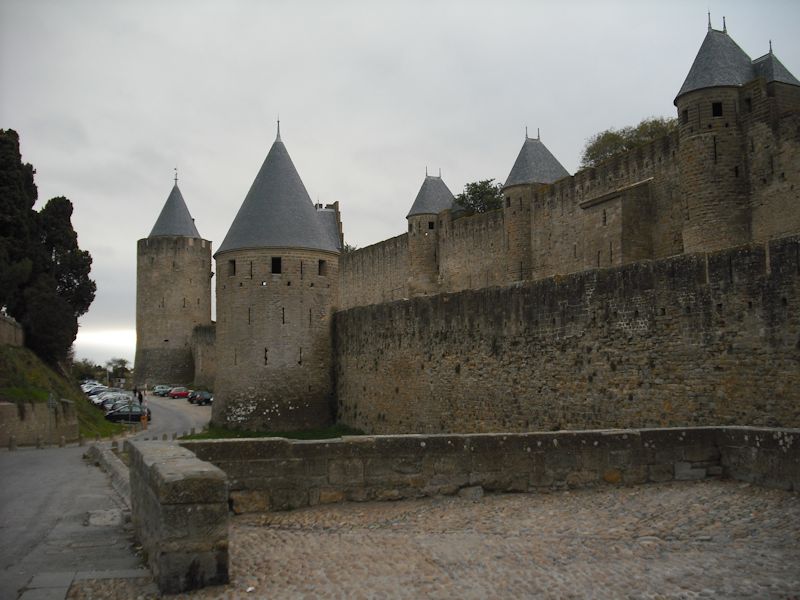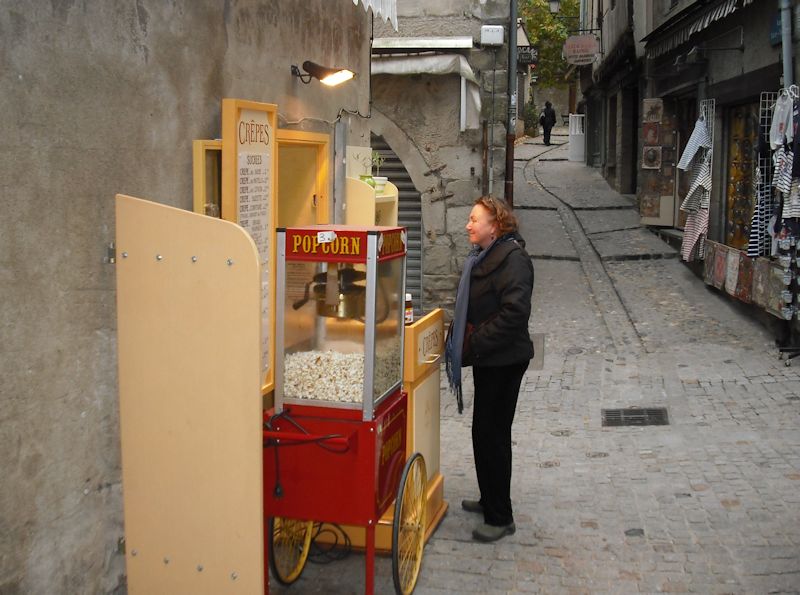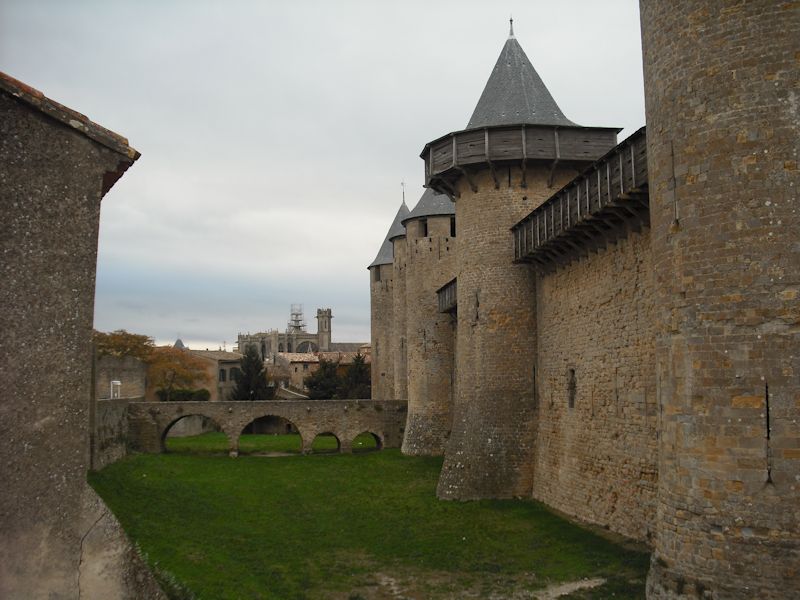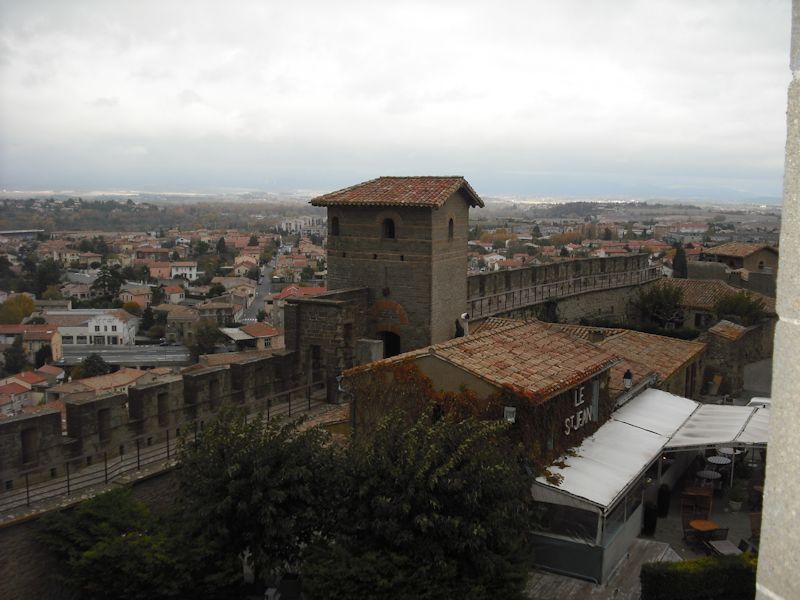You
may not find this terribly rewarding unless you're included here, so this is a
good time for casual and random browsers to turn back before they get too caught
up in the sweep and majesty of the proceedings and can't let go.
Castle-hopping in the Pays Cathare
Carcassonne in the off season

This is Carcassonne in southern France on another bleak day in November 2008. I've been intensely focused upon eventually coming here for the past three decades, and now Kristin's cut through all that and we're here.

After a rainy (and expensive) drive on the autoroute from Sarlat past Toulouse to Carcassonne, we're here under the very gates of the old Cité.
This is the driveway of our hotel (Kristin found it on the Web with her 6th-sense for these things) -- two hotels in one, actually: The Hôtel du Château is slightly upscale and hosts the common bar, breakfast room, and pool. The Hôtel Montmorency out the back is a good deal less expensive -- from the outside, it could fit in very well architecturally out the back of a strip mall in Oklahoma, but the rooms are commodious and well-provided. And this is the unbeatable view out the front!

Serious sightseeing tomorrow -- this is just a restaurant reconnaissance. Carcassonne is said to be the largest fortress city in Europe, with three kilometres of walls and 52 defensive towers and barbicans. It's been here, in one form or another, since the Gallic-late Roman walls of the second to fourth centuries, parts of which are still here in the present inner walls of the Cité.

From the main entrance, the Narbonnaise gates, this is a twilit look along the outer walls to the south.

Kristin in the Narbonnaise Gate in November 2008. In the 12th century, the Trenceval family, lords of Béziers and Carcassonne, repaired the old late-Roman walls and built the Château Comtal at the high point inside the cité, but, alas, old Mad Simon de Montfort showed up in 1209 and besieged the place for two weeks in August, and that was that. Very few followers of the Cathar "heresy" throughout the Midi region passed on fond memories of Simon de Montfort to their grandchildren -- in fact, Simon didn't spare many of their grandchildren either. (In nearby Béziers, the Crusaders slaughtered the entire populace, including the non-heretics, in the same year. ("Kill them all, God will recognize his own." -- Abbot Arnaud-Amalric))
The so-called Albigensian Crusade against the Cathar believers turned out by the end to be a French land-grab of what had been border country until that time. (Amongst many accounts of the Crusade, good short ones in English are J. Sumption, The Albigensian Crusade (1978), M. Costen, The Cathars and the Albigensian Crusade (1997), and for a convincing revisionist argument, M. G. Pegg, A most holy war: the Albigensian Crusade and the battle for Christendom (2008).)

In the list between the outer and inner walls. Old Mad Simon was killed, by long-delayed providence, in 1218, and his awful son Amaury tired of Carcassonne and turned it over to the French monarchy in 1226. The redoubtable Queen Mother, Blanche of Castile, on behalf of her son the kid-king, Louis IX, the future Saint Louis, set about constructing the outer ring of walls.

Tickets here. No, the city is free, it's the Comtal Castle and the ramparts, and the museums, that cost money. Unlike Clovelly, where tourists have to pay just to get into town.

So what have we got here? A double city wall, a big church, a "château comtal" in the middle, and a lot of empty lots. Probably with crab grass, broken bottles, and old Chevrolets strewn about.

No, luckily not, the empty places on the map are filled up with such as Blanche of Castile's tea room, with light refreshments and continuous service, and -- note the attentive gaze -- gifts for gourmands.

Don't miss the fascinating "museums"

Like this Haunted House museum. What do you see in a Haunted House museum? I don't know.

One of the two major wells inside the cité walls -- the Plô well is filled in, but this Big Well is 40m deep. So they say. There's a Visigoth treasure hidden down there. So they say.


Along the main street between the Narbonnaise Gates and the Comtal Castle, it's time for a snack.

Ummmhh, popcorn! Not really. We're after a crêpe jambon/fromage the size of a wagon wheel.

-- This way, Mr President.

Hoarding our ham-and-cheese wagon wheel. This is the restaurant, La Marquière, that, after a few misguided tries elsewhere, we settled upon happily as our home away from home. Reasonable prices, great stuff, free glass of wine with the menu, friendly young host, and featuring prominently the regional specialité, the Cassoulet.

Wikipedia: "Cassoulet (from Occitan caçolet) is a rich, slow-cooked bean stew or casserole originating in the southwest of France, containing meat (typically pork sausages, pork, goose, duck and sometimes mutton) . . . and white haricot beans. The dish is named after the cassole, the distinctive deep round earthenware pot with slanting sides in which cassoulet is ideally cooked. Numerous regional variations exist, the best-known being from Castelnaudary, the self-proclaimed 'Capital of Cassoulet', Toulouse, and Carcassonne."
After one Cassoulet, I was hooked.

The Guantánamo Exhibit. Here, they call it the "Inquisition Museum", but nowadays we call it "enhanced interrogation methods".

Back at the place of the Grands Puits, we're just ambling amiably but aimlessly through the city. It's the kind of tourist attraction that you can hang out fruitfully in for several days, getting to know it better and better without getting bored yet.

This is the Château Comtal at the high end of the cité. We'll come back tomorrow.

Looks like a good place to get your specialitées regionales, crêpes, and ice cream, if that aged paedophile gets out of the way.

We're scoping restaurant menus along the Rue St Louis towards the famous Basilica Saint-Nazaire, absorbing ambiance.

Some of the wall

Bistro'Fruit and its well-known pizza

Chez Saskia, in a fascinating building facing onto the Place Saint-Nazaire outside the church

Chez Saskia again (an amazing building). In some times and places, taxes were paid on the ground-floor footprint, so people then "jettied" out some extra room on the upper floors.

The front door of the main church, Saint-Nazaire and Celse Basilica. Yes, that's it on the left, tucked in discreetly amongst the boutiques. The Romanesque nave was begun in 1096 and built throughout the 1100s, with Gothic elements added from 1269 through the early 1300s.

A heartfelt appeal

The Tomb of the Unknown Bishop

A poignant memorial to the victims of the bombings of Baghdad (or Hanoi, Managua, Hiroshima, Panama, Afghan wedding parties, Beograd, Cambodia, Gaza, Dresden . . . ).


Chez Saskia

The Plô city well

The Eternal Call of the Menu. Few regions have got more specialités cooked in goose fat than the Languedoc. The Provençe to the east has got olive oil, but it's not the same.

Outside the Narbonnaise Gates, a lovely old-style carousel that doesn't turn the kids upside down and make them throw up.

We're back. Another grey day. Here are the Narbonnaise Gates as we come back to see what we've missed on the first round.

We're up the main street, and here's the outer front gate of the Comtal Castle, or Castle of the Count.

Now we're just inside the Outer Outer Gates of the Château Comtal within the cité, and next comes . . .

. . . the Inner Outer Gates.

The Court of Honor within the castle

The Midi courtyard alongside the main courtyard of Honor -- this one was probably not entirely a courtyard, originally, as the arrangements up on the walls indicate.
Kristin and ramparts, still within the Château Comtal

The Cour d'Honneur from the castle walls

Looking out at the entrance gate and ticket-takers

The Tour des Casernes, reconstructed to show the older wooden hoardings that were used to shower unpleasantries down upon invaders before the era of stone machicolations built at the top of the walls.

One of the Gallo-Roman towers along the inner city wall. Those with a rounded front, flat roof, and flat back on them are from the late-Roman era.

The Lower City. A view from the old cité down across the river Aude to the "new city" of Carcassonne. I say "new city" -- the part of it along the river is one of the "bastides", the new fortified towns of the 13th century built to consolidate the newly conquered territory after the Crusade, "facts on the ground" as the Israelis would say. The Bastide de Saint Louis was begun in 1247 but trashed utterly in 1355 by the Black Prince Edward of England in his Salad Days. Black Prince Edw. destroyed most of what he could easily get his hands on, but looked up at towers of the old cité of Carcassonne, reassessed his priorities, and went away.

When the rest of the castle has been overrun, a desperate last stand.

A fine museum in the château. Here, a baptistry or washing-up place.

A frieze of pious people. Oh not more of those.

A little "modern art" thrown in amongst the dolmens.

The Court of Honor again. The military significance of Carcassonne plummeted when, in 1659, the Pyrenées Treaty ceded the Roussillon area from Spain to France and the international border shifted southward to the mountains. Carcassonne became just another stone quarry until the 19th century Romantics stirred up interest, the famous historical architect Viollet-le-Duc undertook the restorations, and Carcassonne became a UNESCO World Heritage cultural property in 1997.

Now we're out on the ramparts -- newly connected to the old castle for us tourists, formerly all blocked off lest the townspeople become unruly and difficult to manage. One of the original 4th century Gallo-Roman towers looms ahead (rounded front, flat back, flat roof).

Kristin frequently has to pause on the old city walls to let The Rest of Her Party catch up with her.

The Rest of Her Party

A view over the cité from the ramparts

And, from the ramparts, a glance down at our perfectly satisfactory hotel -- the main Hotel du Château (marked "hotel") and across the road to the left, looking a bit like a Swiss army barracks, the Hotel Montmorency, under the same management.


Reluctant to stop now, here we are in the "lists" (of jousting fame), the area between the inner and the outer walls, where (supposedly) people jousted.

Almost fanciful medievalisms built on top of one another everywhere

Kristin, very stern, amongst strange fortifications, etc.

There are in Carcassonne cité, as perhaps in all towns built from a Roman model, gates at the four cardinal points. The Narbonnaise is the main one -- here we're looking out the Porte d'Aude (on the far side, over the river Aude).

A look back up at the Château Comtal, with the square Tour Pinte, whence the Saracen princess Carcas, having held out in a five-year siege by Charlemagne himself, fell madly in love with the great emperor and, when he gave up the siege and prepared to depart, sounded out the city bells to invite him into the city anyway. Thus "Carcas--sonne". Believe that if you want to.

We're getting dizzy. This is the front of the Château Comtal again, but now we're inside the city walls, again -- but now we're going outside the inside walls again, and then outside the outside walls, too, and then downtown.

Between the walls

Some of the original Roman towers (note the flat top? the flat back? Roman!)

Kristin down the hill towards the more modern town

And a look back up


A look straight up from the riverside suburbs. Surely disheartening for medieval English conscripts and many modern tourists.

A channel of the river Aude. There was a citadel here, covering the important trade routes between the Atlantic and the Mediterranean seas, just 2km away dating from the 8th century BC, as well as the 17th-century Canal du Midi, or Canal des Deux Mers (two seas), connecting the Garonne river from the Atlantic to the Mediterranean coast, which passes right past the McDonald's in downtown Carcassonne. Where we had a cheeseburger that was welcome at the time.

The river Aude

The old cité of Carcassonne, seen from the bridge over the Aude to the lower city of Carcassonne

Some street scenes from downtown Carcassonne





And a bit later -- we've had a McDo cheeseburger and found an International Herald Tribune, and started back up the hill for our evening cassoulet. The street signs below look shiny and bright because my little Fujifilm flash blew them away.
Next -- Tomorrow we're off to see the Pays Cathare
 Dwight Peck's personal website
Dwight Peck's personal website






















































































